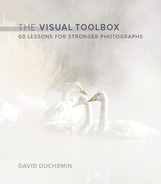Lesson 52. Slow Down
When I started writing this book, I got onto Twitter and Facebook and asked my own circle of friends, fans, and followers about the most significant lesson they ever learned about photography. I was surprised how many of them, given a chance to talk about some great visual revelation, said that lesson was simply to slow down.
Fear of Missing The Shot is a pandemic among photographers, as though there are only so many photographs out there—potential photographs that have grown to this perfect point and must be harvested now before someone else gets them or they die, unseen, on the vine. How many photographs do we need to make? No one will ever see the photographs you do not make, and worse—being so wound up and frantic to “get the shot” will probably blind you to what’s going on. You don’t know the photograph’s there until you’ve made it, and that’s something you can see only in hindsight. No amount of previsualization will guarantee the creative process or that the light will do what you hope or that the moment you anticipate will unfold in front of you. So calm down.
“Rushing through our work is only self-defeating.”
Rushing through our work is only self-defeating, and it sabotages what might otherwise happen if we linger. Lingering helps us see possibilities and alternate angles we might not have considered in our rush. It allows for the ramp-up period most creative people need in order to move into that space most beautifully called flow.
I notice this anxiety in students when I travel. In that location for only a week or two, they’re terrified they’ll miss out and they run helter-skelter, hoping they’ll see it all. But you can’t. Seeing, in photographic terms, is not about what passes before the eyes, but about perception, and we perceive better that which we’ve really experienced. What do you long for: 200 half-baked images of an Italy you think is out there—fast copies of photographs you saw when you did a Google image search or in the pages of the Lonely Planet guide—or a dozen photographs that thrill you, that move you? I don’t know why you photograph, but today’s cameras are so good that if all you want is a record of “I was there,” then put this book down. You don’t need it. Just point and shoot and move on. But if you want something more, then you need to take your time. It is this way with travel, and it’s this way with portraits or landscapes.
Slowing down helps you see better, and it will put you in a better creative space. It’ll help you avoid obvious mistakes. Even just taking the time to scan your frame and check your corners before you press the shutter button will improve your work. But the best reason to slow down is this: You’ll be more aware of the moment itself. Listen, how we live our moments is how we live our lives. All we have is this too-brief time on earth, and rushing through it only gets you to the end faster. Photography is about life—life is not about photography. You can’t photograph what you haven’t experienced, and to experience life, people, and locations, you first have to put the camera down, have a glass of wine, and open not only your eyes but your mind and your heart.

